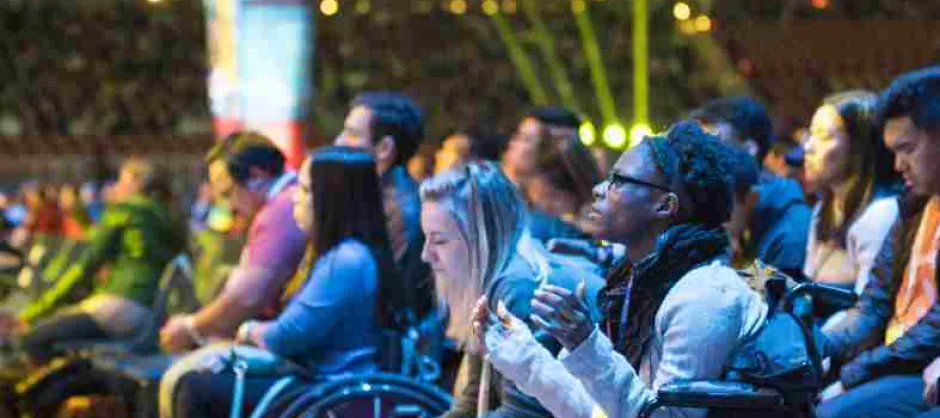
Campus Resources for Access InterVarsity
5 Stages of Disability Awareness

- Ignorance – Lack of knowledge (rude or negative opinions)
- Pity – Feeling sorry (good opinions but ignorant actions, they need healing)
- Care – I can help (good opinions and a heart to help effectively)
- Friendship – Genuine relationship
- Co-Laborers – Serving together
Steps to Starting an Access Small Group
- Ask questions and see if an Access small group is needed (Another option is to help your existing chapter be more accessible.)
- Pick a place that is accessible on campus to meet.
- Invite disabled students and allies to the group.
- Go through the Belonging Bible Study.
Nine Tips for a Disability-Friendly Chapter
These nine practical tips will help your chapter become a more welcoming and disability-friendly community.
- Provide a warm, friendly, welcoming environment.
- Greet people with disabilities as you would anybody else.
- Communicate, in words and actions, that people affected by disability are loved, belong, and are included in your InterVarsity group.
- Provide basic disability awareness training for staff and student leaders.
- Review basic disability etiquette.
- Obtain disability resources or invite a Joni and Friends representative or other disability resource person to do a training session.
- Improve accessibility. Make modifications where necessary.
- Imagine yourself in a wheelchair or having a difficult time with mobility and make changes as needed.
- If necessary, modify the access to the main entrance at a large group or small group event, or move to a new location.
- Provide serving opportunities for people with disabilities.
- God gives all His children spiritual gifts. Include people with disabilities in all areas as you learn their strengths and spiritual gifts, just as you do with all students.
- Provide disability-friendly materials as needed.
- For example, have large print or Braille Bibles available and print song sheets for those who are visually impaired.
- Consider providing assistive listening devices for the hearing impaired.
- Provide space in large group gatherings for wheelchair users.
- Shorten a few rows or take some chairs away so wheelchair users can sit with their friends.
- Provide a sign interpreter for people who are deaf or hard of hearing.
- Provide a mentor/friend for those who might need assistance.
- Someone can offer assistance during meeting times, as well as helping a student with disabilities get across campus if needed.
- General communication and interaction tips.
- Treat people with disabilities as you would anyone else.
- Be relaxed.
- Don’t get caught up with fancy terms such as “physically challenged.”
- In speech and in writing, put the person first, not the disability.
Downloadable Resources - 3x3
3x3 resources give you quick tips: 3 important facts to know, 3 common mistakes to avoid and 3 suggested activities to try on campus.
Welcoming Students with Disabilities
Open 'Welcoming Students with Disabilities' PDF Download DOCX Version
| 3 Things to Know | 3 Things to Avoid | 3 Things to Try |
|---|---|---|
|
|
|
Welcoming Students with Autism Spectrum Disorder (ASD)
Open 'Welcoming Students with Autism Spectrum Disorder (ASD)' PDF Download DOCX Version
| 3 Things to Know | 3 Things to Avoid | 3 Things to Try |
|---|---|---|
|
|
|
Welcoming Students with a Mental Health Diagnosis
Open 'Welcoming Students with a Mental Health Diagnosis' PDF Download DOCX Version
| 3 Things to Know | 3 Things to Avoid | 3 Things to Try |
|---|---|---|
|
|
|
